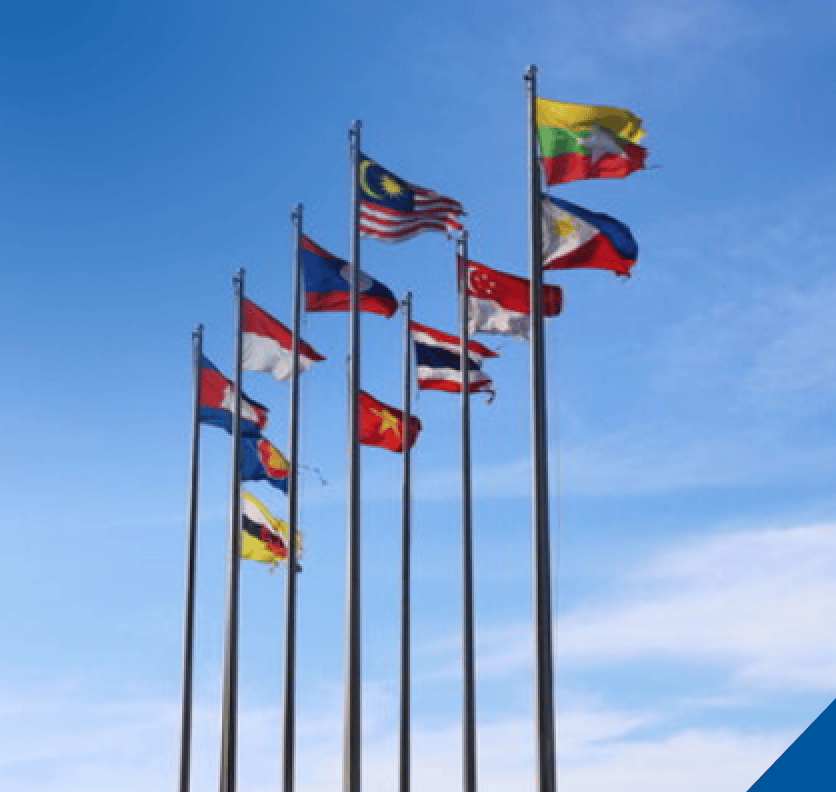[vc_row css=”.vc_custom_1565542682041{margin-right: 0px !important;margin-left: 0px !important;}”][vc_column css=”.vc_custom_1565542696462{padding-right: 0px !important;padding-left: 0px !important;}”][/vc_column][/vc_row][vc_row css=”.vc_custom_1565542751414{margin-right: 0px !important;margin-left: 0px !important;}”][vc_column width=”1/4″][/vc_column][vc_column width=”1/2″ css=”.vc_custom_1565622195563{padding-bottom: 50px !important;}”][vc_column_text el_class=”title-event”][post_title][/vc_column_text][vc_column_text el_class=”author-pers”]By Helena Aurellia and Gabriella Ienanto[/vc_column_text][vc_column_text el_class=”date-venue-news”][post_date][/vc_column_text][vc_column_text el_class=”text-par-news”]The energy sector is in a good position to drive ASEAN’s recovery and its transition to a greener economy.
Member states of the Association of Southeast Asian Nations (ASEAN) were in for a turbulent ride when COVID-19 first reared its head in 2019. The substantial drop in foreign trade and tourism has slowed economic activity in ASEAN significantly, driving the region into deep recession. But with the continuous increase in vaccination rates and scientific discoveries, the region is slowly recovering from the impact of the pandemic.
Although the pandemic is far from over, progress was made last year to advance the energy sector and stabilize the region’s economy. Here is what ASEAN has accomplished in 2021 and why 2022 is off to a good start.
Oil and Gas Rebounds
According to last year’s ASEAN Oil and Gas Updates, oil and gas reserves decreased by 20 percent and 35 percent, respectively, compared to 2010 levels, raising concerns about the future security of supply. This reduction led to frequent power outages and spikes in power rates, which was notably felt in the Philippines and Singapore, respectively.
However, a silver lining is expected in the coming year. While Cambodia’s first production of crude oil stalled, in March, Brunei announced it was beginning a deep-water oil exploration, raising hopes for a robust economic turnaround, with the sultanate hoping to triple oil production by 2025.
In the process of a gradual energy transition, natural gas plays a critical double-role in meeting spiking power demands and as a transitional fuel towards cleaner sources of energy. Accordingly, Indonesia inaugurated the Merakes gas project in June, expecting 368 million standard cubic feet of production per day.
Grand revenue streams such as oil and gas provide an important groundwork for offsetting the economic losses experienced over the last two years. Regardless, oil and gas exploration must be paired with the upscaling of low-carbon technologies as a form of commitment towards the provision of secure and renewable energy.
Decarbonisation Following COP26
Coal is a critical baseload energy source, able to provide the affordable and reliable energy needed for post-pandemic recovery. But its growing environmental impact needs to be addressed. Aligning with the COP26 coal phase-out agreement in late October, ASEAN member states and regional stakeholders were quick in shifting their energy policies.
The third edition of Vietnam’s Power Development Plan 8 issued in February targets the expansion of natural gas to replace coal in thermal capacity development over the next decade. Malaysia set its aim to increase renewable energy shares at 31 percent of total energy by 2025 and scale back coal capacity by 4.2 gigawatts over the next two decades. Three weeks prior to COP26, Indonesia approved the RUPTL, a 2021-2030 electricity plan that eliminates the construction of coal-fired power plants from its future plans while increasing renewable energy allocation to 52 percent. The Philippines is also picking up the pace by planning retirement of 10 coal-fired power plants, and gradually halting new coal power generation projects.
Phasing out coal is one of the most important decarbonisation efforts, which allows more room for renewable energy expansion. However, ASEAN member states have relied on coal for the past decade and will continue to do so until 2040. Therefore, in the meantime, alternative technologies must be integrated in power generation systems in order to reduce greenhouse gas emissions.
Advanced Technology to Facilitate the Energy Transition
Transitioning towards renewable sources of energy will not be easy for ASEAN, given that it requires certain innovations to bridge the gap between the clean energy supply and the region’s rising demands for power. Although some member states have formulated policies to decarbonize the sector, others have resorted to an alternative pathway. Adopting carbon capture, utilization, and storage (CCUS) and high-efficiency, low-emission (HELE) technologies are two promising approaches that can be taken to support CO2 mitigation.
Since 2015, Malaysia has relied on the Manjung ultra-supercritical coal-fired power plant, the first in Southeast Asia with 42 percent efficiency, and will continue to rely on it to supply 23 percent of the country’s electricity needs. Indonesia’s Pertamina is taking it one step further by launching feasibility studies for a CCUS project at its Gundih onshore oil field. The country’s first CCUS project could potentially slash 300,000 tons of CO2 per year.
Although hydrogen-based power generation is no longer a new technology, it has not been implemented much in ASEAN. However, the trend is shifting, and in January of last year the Philippines signed an MoU with Australia to implement its hydrogen energy release optimizer (HERO) technology for emission-free heat generation. While most ASEAN nations are still in the early stages of adopting hydrogen technology, countries such as Singapore are leading in hydrogen fuel cell trials aimed at decarbonising the shipping sector.
Ambitious Renewable Energy Scale Up
The renewables sector has seen a major rework in pursuit of decarbonization. Key findings of the ASEAN Power Updates 2021 reported that renewables made up almost 34 percent of the ASEAN power sector in 2020, leaving only a 1.5 percent gap with the 2025 regional target.
Vietnam has proven itself to be an attractive investment destination for renewables due to its favorable conditions and policies, leading in solar and wind power harvesting in ASEAN. Last year, Vietnam announced its goal to establish Ninh Thuan as its national renewable energy center, where almost a quarter of its 766.45 megawatts of wind-power capacity is in operation. A partnership was also formed between Lao PDR and Japan to establish what will be Southeast Asia’s largest onshore wind farm.
Moving beyond land-based solar panels, floating solar panels are gaining ground in ASEAN, after the world’s largest hydro-floating solar hybrid farm in Thailand finally came online in the third quarter of 2021 after numerous delays. Countries such as Indonesia and Singapore are also constructing similar projects of their own.
Renewables have a crucial role to play in maintaining a sustainable supply while decarbonising and pursuing a greener economy. Investment, technological advancement, and supportive regulatory frameworks will be the determining factors, however, as massive renewable energy injections must be backed with a low-carbon baseload and energy storage to ensure a cleaner, continuous supply.
Strengthening Grid Stability to Meet Increasing Demand
Coupled with grid stability issues, meeting ASEAN’s increasing demand for power became a challenge in 2021. Several approaches were taken, including partnerships, policy evaluations, and the digitalization of the power sector to ensure a stable and resilient power system.
Malaysia recently announced that it is using Capgemini and Google Cloud software to implement an API infrastructure for the nation’s largest power provider Tenaga Nasional Berhad. Meanwhile, back in May, Vietnam’s Internet of Things (IoT) start-up Cloud Energy has developed a wireless monitoring networkto support smart farming. Vietnam’s National Power Development Plan 8 revision includes the allocation of $32.9 billion over the period 2021-30 to improve grid infrastructure.
Power stability may also be secured through the upscaling of energy storage systems, which are an appealing way of maximizing the utilization of harnessed energy. The Philippines is spearheading this, and last year announced plans to scale up its battery energy storage capacity. It even went a step further and announced its intention to create a 54 megawatt floating energy storage facility.
Strengthening power grid stability will remain a key objective for ASEAN governments, especially in the post-pandemic era, where a reliable power supply is crucial for COVID-19 vaccine storage and the overall resilience of the healthcare system. Enhancing grid stability will also allow for greater injections of renewable energy, thus providing a cleaner and more sustainable supply.
Granted, the above are all only baby steps and rigorous work needs to be done in the coming years. Considering the unique characteristics of each form of energy, achieving the appropriate energy mix is crucial to supporting sustainable development. With all these crucial steps taken throughout 2021, ASEAN is now on the right track toward low-carbon development.
However, the big question remains: Will ASEAN be able to accelerate its energy transition while maintaining energy resilience? Or will it get caught up in another detrimental slowdown? We are looking forward to see what 2022 has in store for us.
The original article can be found here.[/vc_column_text][/vc_column][vc_column width=”1/4″][/vc_column][/vc_row]











